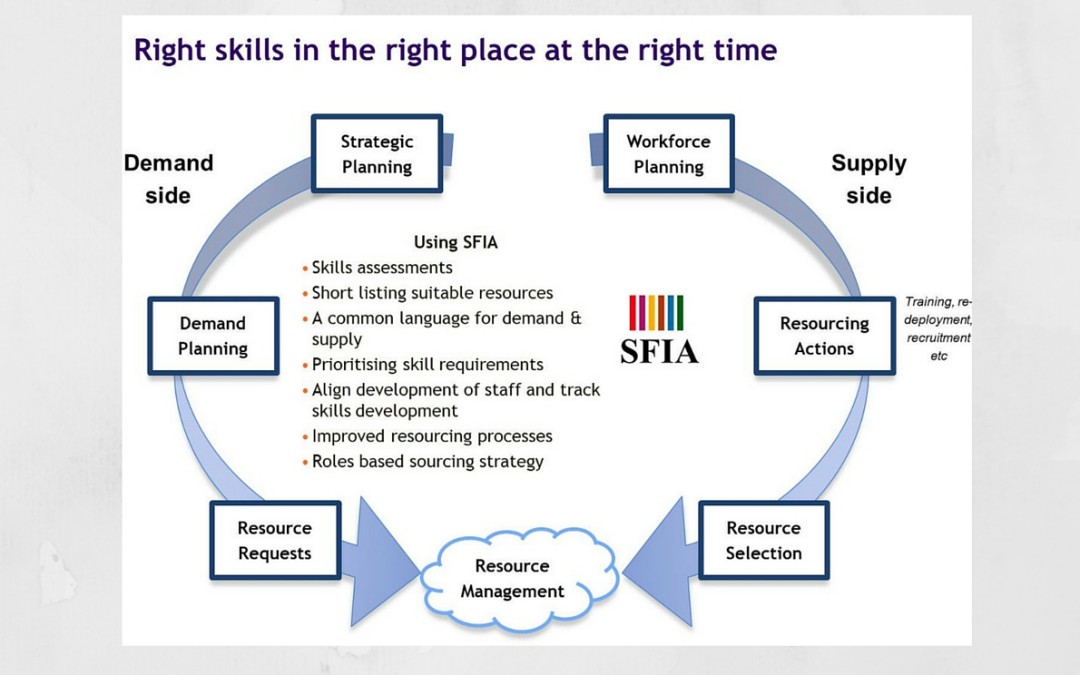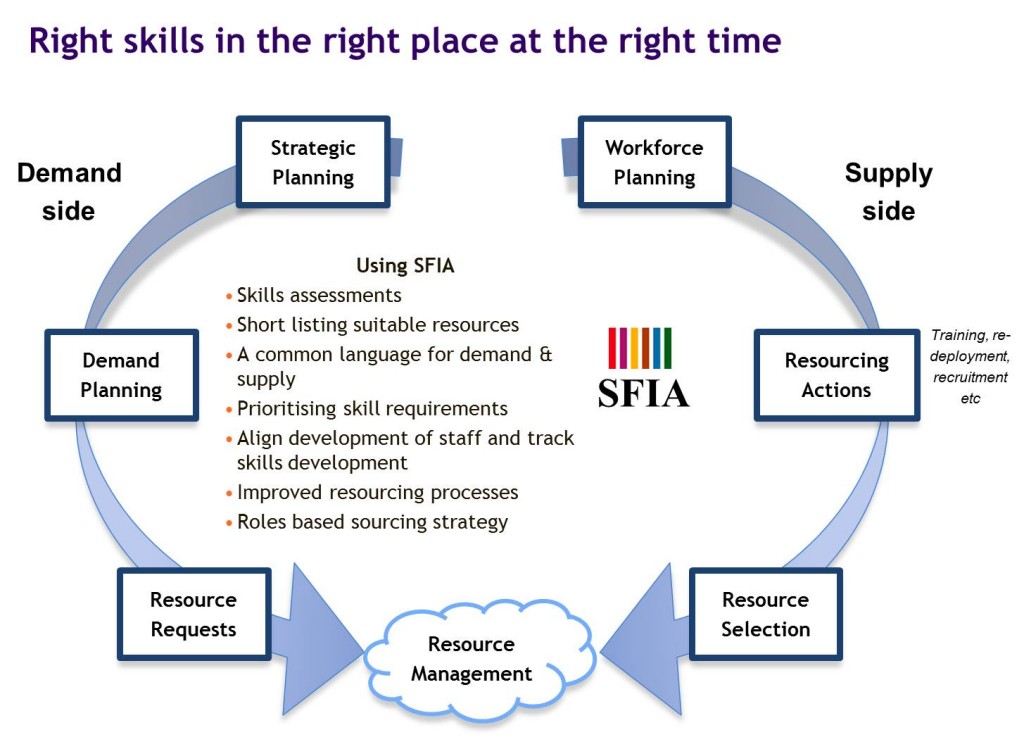12 signs that you should be more strategic with IT resource management
- When asked in industry surveys – your CIO is the one who responds “we have skills gaps but no plan to fill skills gaps”
Matt Ferguson, CEO of CareerBuilder, surveyed more than 2,000 employers. He estimates that 80 percent of them say they are concerned about a skills gap, but only 40 percent are doing anything about it.
- Your resourcing plans only capture head count (e.g. FTE) and cost – no mention of skills and capabilities.
- There’s no clear connection between IT resource plans and your medium / long term business plans.
- Your resourcing team is focused on short term tactical actions – such as shuffling internal resources and sourcing contractors.
- You fill most senior positions by going outside of your own organisation.
- When new roles and skills are needed you usually go external as well. You never seem to have the time or headroom to develop your own people into those positions.
- You are frustrated with recruitment. You can’t seem to source the skills you need at the right price. Your recruiters don’t really understand your needs. People who do join seem OK but can take a lot of support to become fully productive. You have a high turnover rate with your new starters
- Your Training / Learning & Development (L&D) budget is an easy target for cuts. It’s perceived as a cost not an investment. Your Training / L&D team is focused on sourcing courses and certifications. It is not focused on improving performance. What training budget you have goes to those shout loudest. Or it’s spread like butter so everyone gets a thin layer regardless of the business value.
- Your IT organization has a myriad of job descriptions and job titles. Job descriptions are poorly written and/or out of date and unused. There is little consistency or transparency to what your people actually do and the skills they need.
- IT Strategy & Technology Architecture road maps don’t link to resource plans. Skills gaps aren’t recognised as a barrier to strategy execution. Or skills gaps are described in qualitative terms only without any sizing of the skills gap. The end result is a Technology strategy which is not grounded in reality and likely to fail.
- IT managers are disengaged from HR-led talent management processes. The HR-led processes don’t seem to add value or help in the day to day work of an IT manager.
- Your talent management processes focus on leadership roles or high potentials only. They don’t cover all the people / roles you care about.
So what can be done?
The headline approach is identify future demand future, identify supply now and future and then issues and actions.
How often have you heard consultants ask the questions.
What skills do we have now? And what skills do we need in the future?
This question is simple to ask; not so simple to answer. A medium to long term view of organizational skills is hard to pin down.
- At an individual level it can be driven by individual priorities and needs of the current job. That is too short term and insular to close strategic skills gaps.
- Teams can also identify gaps between the demands on the team and how they currently match up. This may also highlight risks or issues to be resolved. This can be future based but if based on team’s current operating model will not highlight gaps on the medium to long term time-scale.
So these two approaches cannot close the medium to long term strategic IT skills and resourcing gaps.
The reason why organisations have skills gaps is because they do not adopt a strategic approach to resourcing.
A strategic resourcing plan is not just about counting heads in a spreadsheet.
- The plan should include the types of jobs and roles needed
- To close skills gaps – we also need to know what skills and skill levels the people in those jobs need. SFIA provides an ideal framework for skills and levels.
- The SFIA capability model also highlights the need to consider the knowledge and behaviours which are needed to for the future organization.
A strategic resource plan is both qualitative and quantitative
In other words we need to know what resource is needed, how many and at what level?
- For example, a purely qualitative description just states “we have a gap in cyber-security skills”, “we need more innovation”, “we must be better at collaboration”.
But to be a real and executable strategic plan – we need to include numbers of people, and levels of capability. We need dimensions that are measurable, track-able and achievable.
Strategic resourcing is a dynamic process not a static one.
- Numbers of people, roles, skills are constantly changing. People retire, leave the organization, get promoted. A good plan takes this into account and drives well informed decision-making not a static budgeting process.
What are the key actions to prepare the workforce?
Workforce preparation actions are the activities and processes which implement a resourcing strategy. This is not limited to recruitment or resource deployment. There are a range of activities which directly or indirectly determine your organization’s skills and capabilities.
e.g.
- Recruiting
- Hiring
- Transfers
- Promotions
- Redeployment
- Use of contingent and temporary staff
- Outsourcing of work (when done to eliminate the need for staff)
- Retirements
- Terminations
- Retention
- Focused development to support specific staffing plans. E.g. accelerated training needed to implement a rapid redeployment of stuff)
- Staffing related compensation changes (e.g. those needed to attract or retain key talent)
Why are most IT organisations are not investing in strategic resourcing?
- It sounds too hard
- The benefits unclear
- It’s important but not urgent
- It struggles for attention against fire fighting and tactical, short term resourcing activities.
The best way to change this is to demonstrate that strategic resourcing has short term benefits.
The immediate benefits of strategic resourcing
- Helps to make more effective short term resourcing decisions.
- Focus on plans and actions; not just analysis and reporting
- To solve immediate business issues and skills or resource gaps
- To create momentum and build a foundation for longer term planning
- To feed other HR / people management processes such as recruitment, learning and development and career paths
How do we get HR and senior managers involved?
- Make it easier – SFIA is a key tool which can make things easier. As are generic roles / professional roles.
- Provide solutions to pressing issues, managers will take part if you are solving issues which affect them.
- Make it business impact focused. Managers do not want to follow a box filling process with questionable value
- Focus on critical issues – not a sheep dip. To inspire confidence and deliver value we need to focus on areas which matter to senior IT managers and HR. Focus on the roles / skills which are strategically important.
- Make it business lead – it should be lead by the IT leaders and managers. It should not be driven by HR.
- Make a conscious effort to engage and enthuse people in the process. The work should be interesting, should be structured and facilitated to make people want to take part.
Benefits for IT organisations
- Add value, provide direction for short term (one planning cycle) tactical actions
- Provides the lead time for the organization to respond. Most resourcing actions need time to e.g.It takes time :
- To build internal capabilities
- To implement apprenticeship schemes
- To develop technical leaders
- To build engagement
- To build communities
- Support employee value proposition. Provides a long term context for activities which support employee engagement and retention. This aligns actions and ensures they are supportive of a longer term plan and culture.
- Career development, career plans, coaching and mentoring are aligned to the plans of the organization. They are a means to an end not an end in itself.
- Developing your own people from within. This mindset maximizes internal career development moves / promotions. It increases engagement, workforce productivity and reduces costs and risks. It also encourages development of a strong culture. Developing your own people that it is a characteristic of high performing organisations.
- Efficient resourcing will improve cost and time
- Effective resourcing will align business and resource planning
- Having an IT strategy which is grounded in reality, its more likely to happen
Benefits for line managers
- Their teams have the resources to do the work
- Motivated employees are more productive
- Confident that talent management processes will provide good quality people
- Confident that other teams, departments have people with the right skills
- Feel good about being pro-active. The right resources are available in a timely fashion
- Processes are clear, its not who shouts loudest
Benefits for individuals
- Career development, career plans, coaching and mentoring are aligned to the plans of the organization. They are meaningful and realistic, not just slide-ware.
- Engagement – individual are attracted to and will stay at organisations which demonstrate a long term commitment to people
- People can see how things operate, they see the organisation develops its own people and that learning and development is an investment in individuals not a cost.
Recommended reading: Strategic staffing, 2nd Edition by Thomas Bechet



